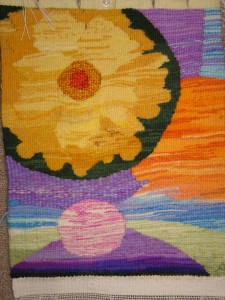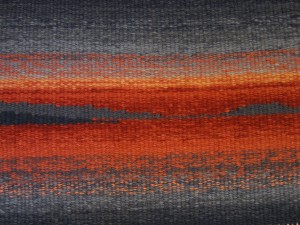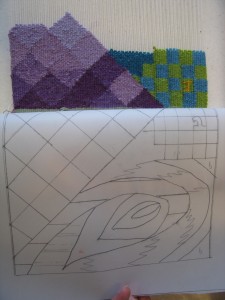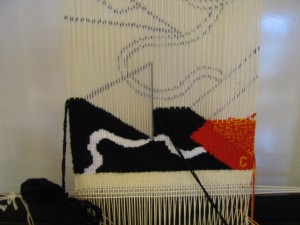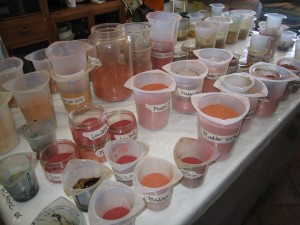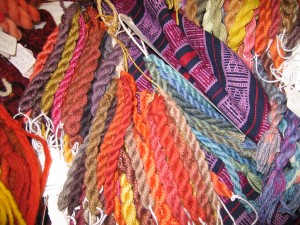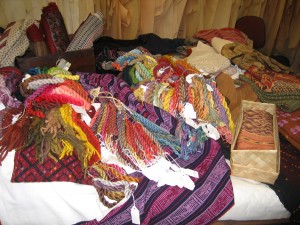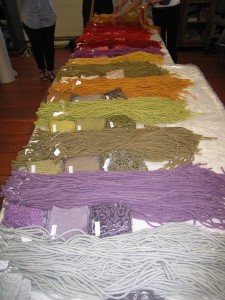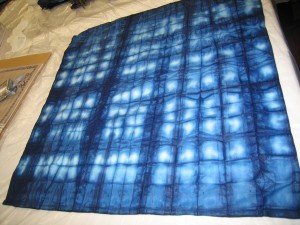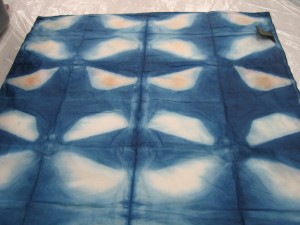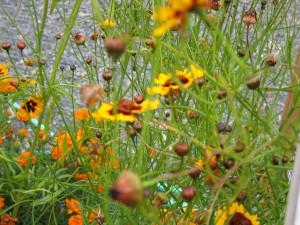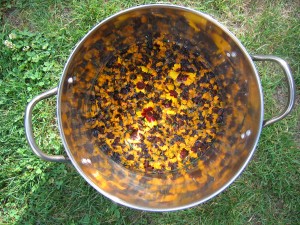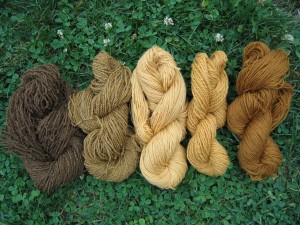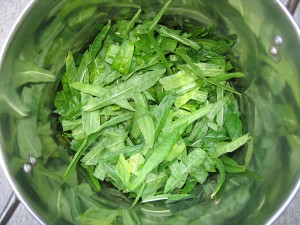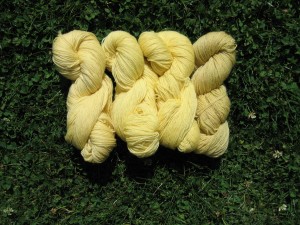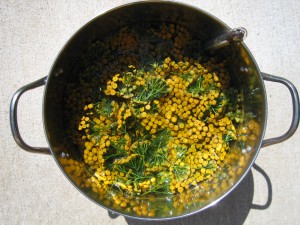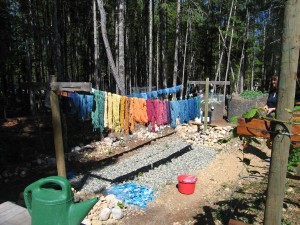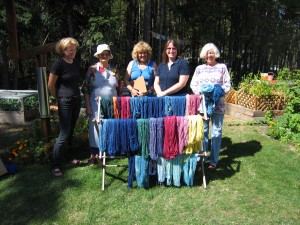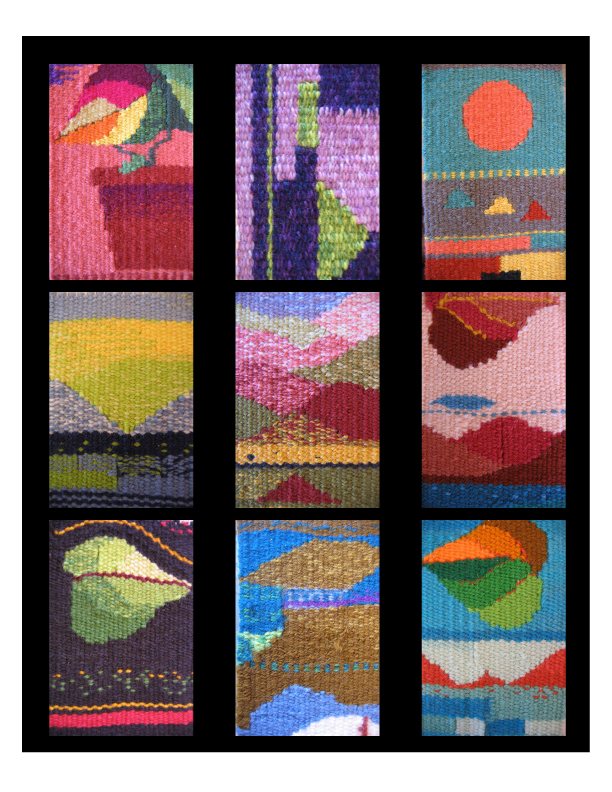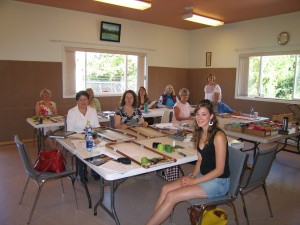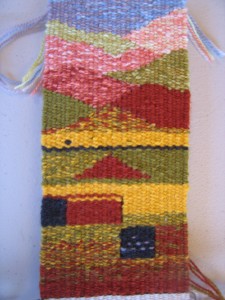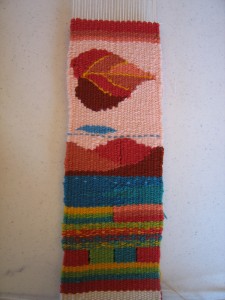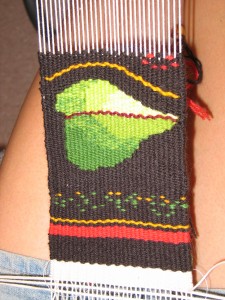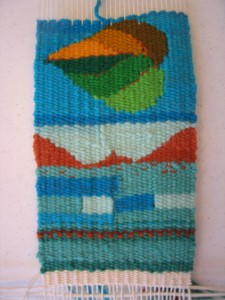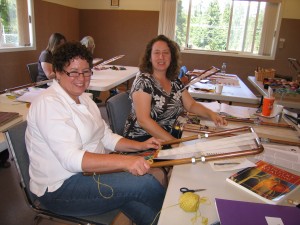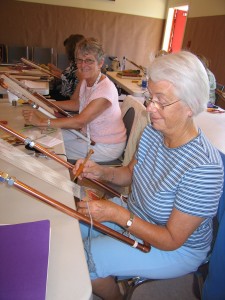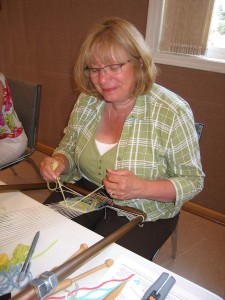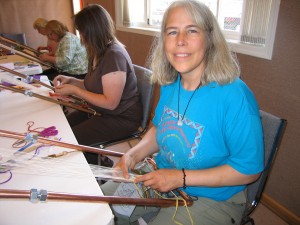Blog Posts
Intermediate Tapestry Weaving Course
by Elaine on Oct.26, 2009, under Blog Posts
I just finished teaching an intermediate tapestry weaving course this past week. Eight people attended from the Pacific Northwest area. I had chosen the theme of Shapes and Shading. The first day was spent designing a cartoon based on this idea and warping the looms. The next three days were for weaving, looking at tapestries and discussing tapestry. After the class on the second day we visited local tapestry weaver, Christine Rivers, who spoke about her work, showed her tapestries and answered questions. Everyone found it very inspiring. We had some wonderful show and tell during the first day by students who had been working on tapestries over the past few months. Ann Robertson brought her completed tapestry on a loom and we all enjoyed the cutting off ceremony. Marianne Sakik wove a small tapestry based on a sunset over the water. She presented both the finished tapestry and the photo she had used for inspiration. Cande Walsworth shared a photo of her pear tapestry she had worked on in a class this summer with Archie Brennan and Susan Martin-Maffei in Oregon which was organized by Pam Patrie. Bertie Smiley showed us a tapestry sampler she had woven from an issue of Handwoven. I think the class did very well with the theme and all left with inspiration and wanting to get together again next summer for another session.
Natural Dye Workshop at Maiwa East
by Elaine on Sep.27, 2009, under Blog Posts
Just got back from 4 days of dyeing with natural dyes taught by Charllotte Kwon at Maiwa East. This course is part of the Maiwa Textile Symposium for 2009, “Every thread has a story”. Sixteen people from across Canada and the state of Washington attended the workshop. Charllotte had two able assistants: Anne and Naomi, as well as help from her daughter, Sophena and son, Craig. The first day started with a slide presentation and lecture on natural dyeing with Charllotte. Then in the afternoon we split into pairs and started to mordant the yarns which had been previously scoured. We would work with cotton, linen, hemp, wool, silk, alpaca, and silk and rayon blends. Some fibres were in the form of yarns and others as fabrics. Each person had their own mordant pot and burner. At the end of the day we had mordanted all the fibres and would be ready to start the dyeing process the next morning. We mordanted with alum and tannin.
The next morning we again each had a dye pot and burner and worked in pairs and proceeded to dye all day long. The dyes included: fustic, osage sawdust, madder, lac, cochineal, cutch, logwood, marigold, henna, pomegranate, myrobalan and iron to sadden the dyes. The dyes were pre-measured and each pair was assigned the dyes and appropriate yarns/fabrics to use. Each person dyed 4 sets of dyepots and fibre. At the end of the day, we had completed 64 dyebaths.
On the third day, we sorted out the dyed samples and labelled them appropriately.
I have included a photo of the textiles that were shared with us for inspiration.
After labelling our fibres, we spent the afternoon preparing for the next day of dyeing with indigo. Anne taught us various ways to do shibori—stitching, clamping, folding, using ikat tape and thread for resist.
The last day we spent dyeing with vats of indigo. We were taught how to make the vats and the importance of how to dye in the vats without introducing alot of oxygen into the vat. Our list of dyeing was long: yarns to be overdyed; 3 unbleached cotton squares, 4 bleached cotton dinner napkins, a handwoven cotton scarf, and then some people had brought extra items. Each person had her own vat.
After exhausting our indigo vats and rinsing our fabrics, many students removed the clamps, stitching and ikat tape to see the wonderful results. Charllotte had also made some dye extracts for us to use to paint on previously mordanted skeins of wool for a direct application of dye with brushes or sponges.
It was a very full 4 days of inspiration and fun and play. I have spent the last three days since getting home from the workshop putting my book together. We were given wonderful instructions to attach the yarns and fabrics to our notebook pages. This book when I completed it this afternoon is a great reference as well as being aesthetically pleasing. It was also a great review of everything we accomplished during the workshop. I highly recommend anyone interested in natural dyeing and natural fibres to take this workshop. The inspiration is worth the price alone!
Natural Dyeing with Dyer’s Coreopsis
by Elaine on Aug.26, 2009, under Blog Posts
Today I dyed using the flowers of the dyer’s coreopsis. Last evening I harvested the rest of the blooms from the plants and added them to the collection of frozen ones I had been cutting all summer. I simmered them for about an hour, then left in the pot overnight. This morning I removed the plant heads/blossoms and strained the remaining liquid adding enough water to cover the skeins of yarns. I immersed the alum mordanted wool skeins (one natural white colour, one natural grey and one natural brown). I brought the pot up to simmer and kept it at that temperature for about an hour. The exhaust bath also gave a beautiful strong golden colour although not as dark as the first dye bath using two natural white coloured wool skeins. You can see the results in the photos. I was very pleased with the intensity of colour.
Natural Dyeing with Weld from the garden
by Elaine on Aug.24, 2009, under Blog Posts
I planted a natural dye garden this spring: Weld, Woad, Dyer’s Coreopsis, and Marigolds. I already have three tubs of Madder as well. I cut the leaves of the weld–they were in the form of rosettes and had not flowered yet. I have included photos of the weld in the dyepot and the resulting skeins of yarn. I was able to dye 4 – 2 ounce skeins and get very good concentration of colour. The skein on the right was from the first dye bath and is more green-yellow. The subsequent dyebaths gave very clear intense yellows. I just cut the leaves,immersed them in water, simmered for an hour, left in over night and strained them out in the morning when I proceeded to dye. I was very happy with the results.
Natural Dye Days
by Elaine on Aug.24, 2009, under Blog Posts
I held Natural Dye Days at my place this month of August. Yellow day was August 4th where we dyed wool yarns with Fustic as an extract, Osage Orange in sawdust form and Tansy flower heads collected from my neighborhood. On Red Day, August 11th, we dyed with Madder from dried roots given to me by a friend, Cochineal from Peru and from Mexico, and Lac purchased ground from Maiwa Handprints. And lastly on Blue day, August 18th, we dyed with natural indigo and synthetic indigo, also overdyeing the yellows and reds to get purples and greens. I have included a few photos so you can see the wonderful rainbow of colours we got.
Beginners Tapestry Course Group Photo
by Elaine on Jul.31, 2009, under Blog Posts
Marianne Sadik sent me an email recently of a group photo of the weaving samplers the nine people in the summer beginners tapestry course. I have included it here for your enjoyment. Thanks Marianne for sharing it.
ATA — Blog Tech
by Elaine on Jul.25, 2009, under Blog Posts
Blog Tech
Are you curious about what drives artists to blog? Are you considering starting your own blog? The American Tapestry Alliance’s latest edition of the Educational Article series offers technical and inspirational insights into artists’ blogs. It is hosted on the ATA website at: http://www.americantapestryalliance.org/Education/Ed_Ar/BlogTech/BTLaneIntro.html
I just received an email from Mary Lane that the Blog Tech article that I, Jan Austin, Debbie Herd, Lyn Hart, Tommye Scanlin and Kathe Todd-Hooker participating in writing is alive on the website. I hope you enjoy the articles where these tapestry weavers talk about writing blogs and show photos of their work inspire you!
Beginners Tapestry Course
by Elaine on Jul.20, 2009, under Blog Posts
I just finished teaching a 4 day beginners tapestry course last Friday. There were 9 students — some local and some who had travelled a long distance to come here. It was a great group of students who were very enthusiastic, worked hard and played hard. One day after class we visited the studio of local tapestry weaver, Linda Wallace. Another evening we all went out to dinner together. The out-of-towners found time to visit our local Tuesday night market in Parksville as well as other sights, such as our local parks and restaurants, and walking on the beach. I have enclosed some photos of the class and their accomplishments. We hope to meet again next summer, same time and place and continue with our tapestry journey.
Lecture with Jane Kidd
by Elaine on Jul.04, 2009, under Blog Posts
“Contemporary Tapestry Work and Influences” a lecture with Jane Kidd will be held on Wednesday, July 29, 2009 at the Bayside Inn (Court Room) in Parksville, BC at 7:30 pm. Jane Kidd is coming to the Parksville area to teach a 3 day workshop for the local tapestry study group weavers. The course is full but Jane has offered to give a lecture to the public the evening of July 29. Needless to say we are very excited to have Jane visit with us and share her enthusiasm for tapestry. In the meantime, those of us who are participating in the workshop are gathering our resource materials, ideas and equipment together for three days with her. The course has to do with strategies for design and she will work with each person individually as well as with the group. Each participant was asked to bring 1 or 2 ideas they would like to work on. I will report more on this event later.
Intermediate Tapestry Class
by Elaine on Jun.29, 2009, under Blog Posts
Last Wednesday, June 23 was the last of a four day course for intermediate tapestry weavers. Eight students and I met from 9:30 am to 3:30 pm to discuss new projects and new techniques as well as getting started again on old projects. What most of the class wanted was inspiration and a jump-start. The first day each student told the others what they would individually like to accomplish in the class. You can imagine that the challenges, projects and goals were as diverse as the eight people taking the course. A few people did samples of demi-duite, others of hachures. Some worked on cartoons and designs and others continued on previous projects. The class had fun making up sayings about what they had learned in the hopes of remembering these words of wisdom when weaving on their own. I thought we should make a list and share with others some “rules” (loosely worded please note). I always remember a “rule” that Jan du Bois of Santa Fe said: if you cannot decide whether to move over one warp thread or not, then don’t. Janine Wilkins from our class said her new “rule” was: you just can’t start anywhere. Also you must complete the pass in order to remain in the right sheds. If you are in the wrong shed, use the half pass to get you going again. Archie Brennan’s rule on designing: SIMPLIFY! We had lots of good giggles and shared inspiration in this class and we look forward to getting together again in the Fall.
